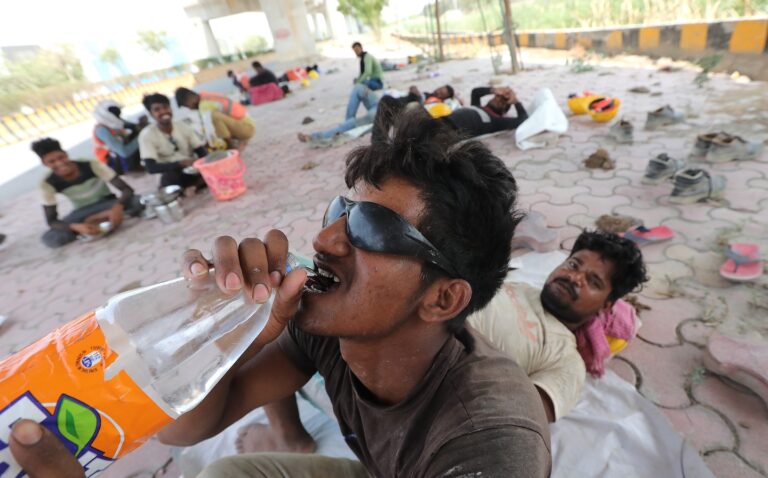This seems natural: before the summer even began, heat waves had already hit various parts of the planet, from Bangkok to Barranquilla. “By the end of May, more than 1.5 billion people, nearly a fifth of the planet’s population, had endured at least one day with a heat index above 103 degrees Fahrenheit (39.4 degrees Celsius). According to my colleague, this is “the threshold that the National Weather Service considers life threatening.”
May also marked the 12th consecutive month that the global average temperature exceeded all recorded temperatures since 1850. A group of 57 scientists released a report this month saying that human activities were responsible for 92% of the warming that occurred last year, the hottest year in Earth’s history. Scientists also expect at least one year in the next five years to surpass the global annual average temperature record set in 2023.
Get caught up in
Stories to keep you up to date
“Researchers link the rise in temperatures to El Niño weather patterns and decades of global warming from human greenhouse gas emissions,” my colleague Scott Dance writes. “A decade ago, scientists estimated there was a near-zero chance that the planet would warm by 1.5°C by 2020,” the threshold at which the scientific consensus is that temperatures higher than pre-industrial levels would bring the planet to climate disaster. Now, the chances of that happening by 2028 are estimated at eight in 10.
In other words, climate disasters are in many ways I’m here already. My colleagues predicted last year that by the middle of this century, roughly 5 billion people on Earth will be “exposed to health-threatening heat when outdoors in the sun for a month,” a figure that will already be 4 billion by 2030.
In April, a record-breaking heatwave in Asia sent temperatures soaring to 100 to 120 degrees Fahrenheit in an arc from the Philippines to India. “Thousands of records are being broken across Asia, making this the most extreme event in global weather history.” Meteorological historian Maximiliano Herrera wrote about X.
“When the air is humid, sweat doesn’t evaporate as quickly, so sweating doesn’t cool you as well as it would in a dry environment,” said Scott Denning, a professor of atmospheric sciences at Colorado State University. “In parts of the Middle East, Pakistan and India, you get a combination of summer heat waves and humid air blowing in off the ocean, and that combination can be really deadly. These regions are home to hundreds of millions of people, most of whom don’t have air conditioning indoors.”
The estimated effects of climate change also point to growing global disparities in the experience of climate change. “Long-term projections suggest that future warming will lead to milder winters that will spare wealthy northerners,” my colleague Harry Stevens writes. “But summer heat will become more dangerous in hotter, poorer countries where it is hardest to afford air conditioning, where poor workers have the hardest time taking time off work, where water is scarce, and where power grids are unstable.”
Public health experts are understandably concerned about the resilience of communities living in an era of climate change. The latest World Risk Poll Resilience Index, produced by Lloyd’s Register Foundation using data collected by Gallup, surveyed 147,000 people in 142 countries and found that a global rise in people “says they can do nothing to protect themselves or their families from the impacts of future disasters.” Climate change is clouding these sentiments, contributing to what the index authors suggest is “a global loss of agency and a growing sense of powerlessness.”
The index scores the level of resilience of individuals and societies around the world, defined as “the ability of people to cope with the shocks they face in life and to return to ‘normal’ or near-normal states afterwards.”
Nancy Hay, director of evidence and insight at the Lloyd’s Register Foundation, an independent international charity, said the organisation’s research “clearly shows that some people are more vulnerable than others, with the poorest fifth of households disproportionately more likely to have lower resilience scores than better off households,” adding that gender disparities also play into the equation: “Across all 141 countries featured in the index, women’s resilience scores are equal to or lower than men’s, highlighting the importance of women’s empowerment as a key component of climate resilience interventions.”
However, the political situation in the West does not suggest much focus on these issues. In Europe, environmental policies have sparked a right-wing nationalist backlash in national elections in both countries and in a recent vote in the European Union Parliament. In the United States, federal scientists at multiple environmentally focused agencies are desperately searching for ways to protect their research and government authority if former President Donald Trump, who openly opposes many of the regulations and protections they promote, returns to power.
All the while, climate alarm bells continue to ring. “With every turn of the calendar over the past year, temperatures have risen,” UN Secretary-General António Guterres said this month. “The Earth is trying to tell us something, but we don’t seem to be listening.”


